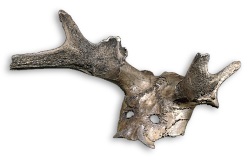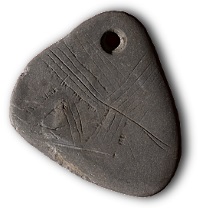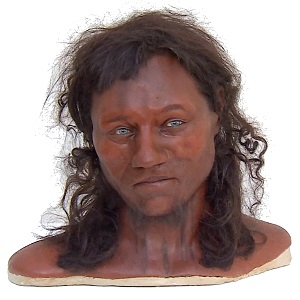IN THE BEGINNING
The Mesolithic: c. 10,000 BC – c. 4000 BC
Our story begins in about 9600 BC, when the last Ice Age finally came to an end, marking the start of the Holocene, the current geological epoch. At that time, Britain was undoubtedly connected to the Continent by country, known as Doggerland, that now lies beneath the southern North Sea. As temperatures quickly rose and the land thawed, people moved-in to occupy what was to become Britain. There is less certainty about Ireland. Although it is widely supposed that there must have been a land–bridge joining Ireland to Britain, to account for the post-glacial colonization of Ireland, there are geological difficulties and its existence has not been proven.
mig01
With the coming of a warmer climate, a new fauna found it possible immigrate into Ireland, probably across a short-lived land-bridge between north Antrim and Kintyre. One result of the early separation of Ireland and Britain is that Ireland has today a much narrower range of plants and animals than has Britain.However, geoscientists Robin Edwards and Anthony Brooks**:
The level of the sea relative to the land surface (relative sea-level) results from the interplay between vertical changes in both land and sea level. These processes can be simulated by computer models that describe the response of the solid Earth to the loading and unloading of glacial ice (glacial rebound models). In addition to simulating relative sea-levels, the output from these models can, when combined with bathymetric and topographic data, be used to produce first-order palaeogeographic reconstructions… These reconstructions are derived from a recently developed glacial rebound model for Ireland that incorporates an updated British-Irish Ice Sheet component and is trained by geological sea-level indicators from around the Irish coast. The resulting reconstructions suggest that Ireland was separated from Britain by c.16,000 calendar years ago, at which time climate was still cold and local ice caps persisted in parts of the country. No support is found for the idea that a Holocene land-bridge was instrumental in the migration of temperate flora and fauna into Ireland.* Ireland in Prehistory (first published 1977, reprinted with corrections 1978, in paperback 1989, reprinted 1996, transfered to digital printing 2006) Chapter 2.
** ‘The Island of Ireland: Drowning the Myth of an Irish Land-bridge?’, in the Irish Naturalists’ Journal Vol. 29 Special Supplement ‘Mind the Gap: Postglacial colonization of Ireland’ (2008).
At any rate, the meltwater of the retreating ice caused sea-levels to rise and any land-bridge soon disappeared. Eventually, as Doggerland became submerged, round-about 5500 BC Britain became an island.
mig02
The date of this event [i.e. when Britain became an island] is in debate. Traditionally it was believed to be 7500–6500 BC, but recent work on molluscs found in sequences of sediment, reflecting changes of habitat from freshwater to marine conditions, suggests that the final breakthrough was significantly later, between 5800 and 5400 BC, and it may be that it was not until 3800 BC, with an increasing tidal range, that the Channel to North Sea connection was fully established.Incidentally, Professor Cunliffe proposes that a land-bridge between the north of Ireland and the Inner Hebrides was breached c.9,000 BC. * Britain Begins (2013) Chapter 2.

Mesolithic (Middle Stone Age) people lived by foraging, hence they are referred to as ‘hunter-gatherers’. The animals which they killed for food also provided them with bone and antlers, from which tools or weapons could be made, and skins, which could be utilised, not only for clothing, but as sacks and water carriers. They would have also employed wood, reeds and grass, clay, flint and stone. Particularly associated with the Mesolithic Age are small flint blades, of various shapes, known as ‘microliths’. There is archaeological evidence to show that these blades were used to provide the tips and barbs of arrows. It is conjectured that, fitted into handles of wood or bone, they formed the cutting parts of various types of tool.

HOWICK
During the summers of 2000 and 2002, archaeologists excavated the remains of a Mesolithic house at Howick, Northumberland. Successive rings of stake-holes provided evidence that the house (roughly 6 metres in diameter) had been completely rebuilt twice since its original construction. Radiocarbon dating of charred hazelnut shells, found in a sequence of hearths, has shown that the house was first built c.7800 BC, and indicates it was in use for around a couple of centuries before it was abandoned, though whether this was on a permanent or a seasonal basis is not clear.


STAR CARR
An important site for evidence of life in ‘Britain’ during the Mesolithic period is Star Carr, near Scarborough, North Yorkshire. At the time the site was in use – over an 800 year period, from c.9300 BC to c.8500 BC – it was beside a lake. Animal and plant remains have been well preserved in waterlogged peat at the erstwhile lake’s edge. The earliest excavations at Star Carr, in 1949–51, produced a large collection of worked flints, butchered animal bones, and bone and antler artefacts. The extent of the Mesolithic site was not, however, appreciated at that time. Investigations undertaken since 1985 suggest that it covers almost 2 hectares. The site’s occupants were actively managing their environment by deliberately setting fire to the reedswamp along the lake edge – either to improve access to the lake, or, possibly, to encourage animals to feed on the fresh reed shoots which sprang up. The remains of three wooden platforms – making use of planks split (by hammering wedges into the wood) from tree-trunks (mainly aspen, but also willow), several of which were further worked with flint tools – laid on the swampy margin of the lake have been discovered. The largest, and earliest, of these is 6 metres wide and over 17 metres long, and was built c.8950 BC – the others were built, either side of the first, one after the other over the following two centuries. Perhaps they provided easy access to boats. Though no boats have been found, there is a possible paddle, and, in any case, evidence of Mesolithic activity on islands in the lake indicates that boats were in use. Since 2008, excavation inland from the lake-side has revealed the postholes of at least four structures (this probably represents a fraction of the buildings on the whole site). In 2015 an engraved shale pendant was unearthed from the lake-edge deposits. It is considered likely that the pendant and other choice finds, such as the many antler barbed-points and ‘head-dresses’, were not simply lost or casually discarded, but were ritually committed to the lake. Some animal-parts, including a whole dog carcass, also probably fall into this latter category. Incidentally, no human remains have been found at Star Carr.

CHEDDAR MAN
It is very rare to find complete human bodies in the Mesolithic. Aveline’s Hole, a cave in Somerset, was discovered in 1797. Inside, lay fifty or more skeletons, up to twenty of them reported to have been “perfect”.[*] Sadly, all that now exists is a collection of some eight hundred bits and pieces, of at least twenty-one individuals – men, women, children and infants. Radiocarbon dates indicate the bodies were placed in the cave between c.8400 BC and c.8200 BC. Aveline’s Hole is located in a gorge called Burrington Combe. Nearby is the rather more well-known Cheddar Gorge. In 1903 a complete skeleton was uncovered in Gough’s Cave, in Cheddar Gorge. It was of a male, about 5ft 5in tall, who died in his early twenties. He is known as Cheddar Man, and he was a contemporary of the people deposited in Aveline’s Hole. DNA testing shows that he was lactose intolerant, and suggests that he would have had blue eyes, dark hair and dark skin. The genetic variations that produce light skin and the ability to digest milk in adulthood were, it seems, introduced by later waves of immigrants, thousands of years later.